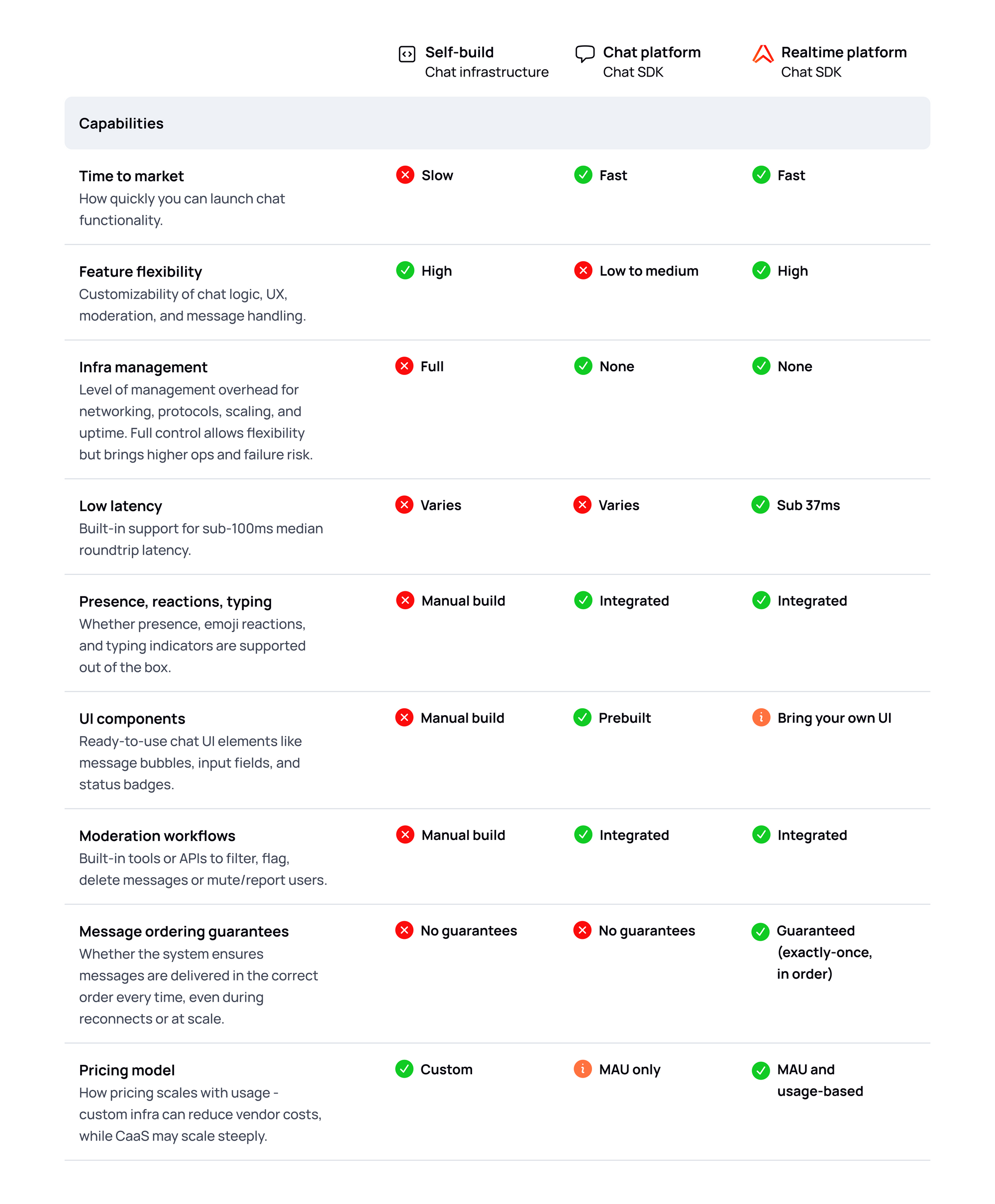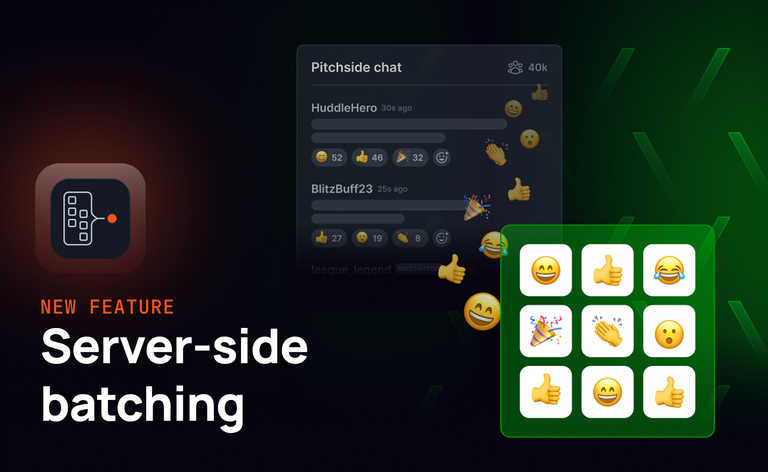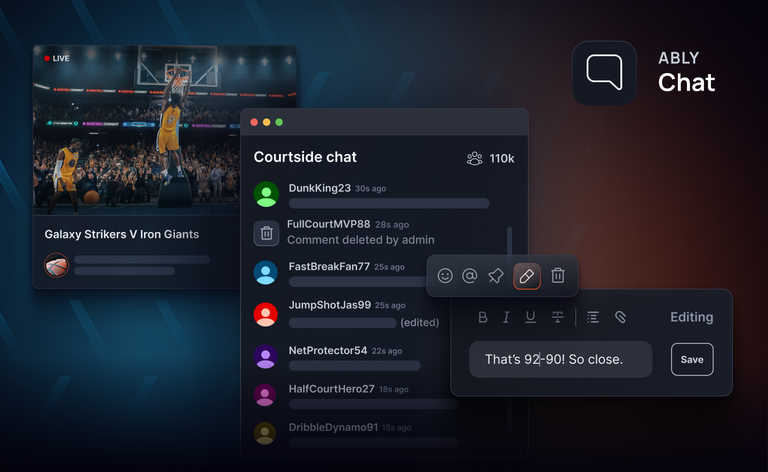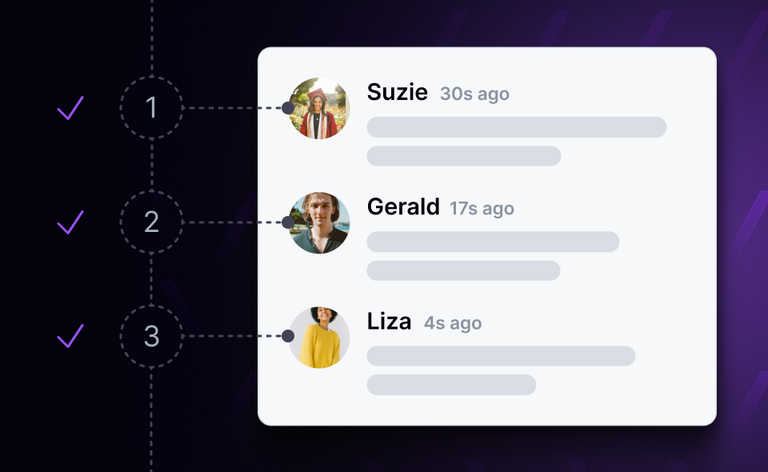In-app chat has gone from a nice-to-have to an essential product feature across gaming, SaaS, social, and live streaming apps. While it’s tempting to treat it as “just another feature,” the reality is that building chat touches nearly every layer of your stack - from low-latency delivery and message ordering to presence, typing indicators, moderation. And then there is operating at scale to consider. That’s why choosing the right architecture up front is critical to avoid complexity and wasted effort later.
There are three common ways to implement chat:
- Build a custom chat backend from scratch
- Use a Chat SDK or Chat-as-a-Service (CaaS) provider
- Use a general-purpose Realtime Platform with a purpose-built Chat SDK (like Ably Chat)
Want a deeper look at the technical architecture behind realtime chat? Read our guide on designing chat architecture for reliable message ordering.
This post picks up on the different options to help you choose the best delivery model for your app - balancing speed, flexibility, scalability, and cost.
Option 1: Building your own chat backend
If your team has strong realtime and distributed systems expertise, building chat from scratch - using tools like Socket.io, SignalR, or WebSocket APIs with AWS infrastructure - gives you full control over every layer of the system. This approach lets you tailor protocols, storage, and user experience to your exact needs. But with that control comes the full responsibility for uptime, message ordering, moderation, and global performance at scale.
Pros:
- Full control over protocols, storage, and message delivery logic
- Custom UI, moderation, and presence models
- No third-party dependency or licensing costs
Cons:
- Long build time and ongoing maintenance burden
- Requires deep realtime infrastructure expertise
- Scaling globally (low latency + ordering) is very hard
Best for: Teams with dedicated infra/ops teams, high custom requirements and deep pockets.
Option 2: Using a chat SDK or CaaS platform
Chat SDKs (like Stream, Sendbird, or Twilio) offer an easy way to embed prebuilt chat functionality into your app. They provide out-of-the-box components and handle all the backend scaling, making them ideal for getting to market quickly. However, that speed often comes at the cost of flexibility.
Pros:
- Fast time to market
- Prebuilt components (messaging, presence, reactions, UI)
- Handles infra, scaling, compliance, and ops
Cons:
- Limited flexibility for unique chat logic or UX
- Hard to extend with non-chat realtime features
- Can get expensive at scale (typically MAU-based pricing), especially with high concurrent usage
- Limited flexibility when it comes to edge network options
Best for: Teams that only require chat, willing to sacrifice flexibility for speed.
Option 3: Using a realtime platform with a chat SDK (e.g. Ably Chat)
A realtime platform like Ably with a chat-focused SDK gives you the benefits of managed infrastructure without locking you into rigid templates. You get a composable foundation built for realtime workloads - with the flexibility to build your own UI and logic on top.
Pros:
- Offers a middle path: fast setup with full customization
- Powered by global pub/sub infrastructure (Ably Pub/Sub)
- Purpose-built Chat SDK with built-in support for presence, reactions, history, and typing
- Flexible room architecture: supports 1:1, group, and livestream-style chat
- Built-in moderation workflows (before/after publish filtering, serverless hooks, integrations with tools like Hive)
- Choice of MAU or usage-based pricing that scales predictably
Cons:
- Requires front-end UI development (bring your own UI)
- More setup than CaaS, less infra freedom than pure self-hosted
Best for: Teams that want realtime reliability and chat primitives, without building infrastructure.
Chat architecture options compared: self-build vs chat platforms vs realtime platforms
To help you choose the best approach for building chat, we’ve summarized the key differences between self-build, chat platforms, and realtime platforms like Ably (with Chat SDK) in the visual comparison below. It highlights trade-offs across speed to market, feature flexibility, infrastructure control, scalability, and more - so you can quickly assess which option aligns with your team’s needs and priorities.

Final thoughts
No chat architecture is one-size-fits-all. If your team has realtime infra expertise and wants full control, self-build may make sense. If speed is your priority, a plug-and-play CaaS might work - just be mindful of limits.
But if you’re looking for a flexible, scalable way to build high-quality chat without the burden of maintaining infra, Ably Chat offers a powerful middle ground. It’s designed to help teams go from prototype to production without compromise. And where realtime is critical to the user experience - no outages acceptable.
Already deep in the weeds of infrastructure? Our scalable chat app architecture guide covers what to plan for from day one.
FAQs
What is the best way to build a chat app? It depends on your goals. Self-build offers control, Chat platforms offer speed, and realtime platforms like Ably and our Chat product offer both flexibility and reliability.
When should I use a chat SDK? Use a Chat SDK when speed to market is more important than full customization.
What’s the difference between a chat platform and a realtime platform? A chat platform offers prebuilt messaging features and is limited to chat use cases. A realtime platform like Ably provides the underlying infrastructure and chat primitives, giving more control and scalability - applicable to a wide range of realtime use cases.
Is building a chat backend worth it? Only if you have the time, budget, and need for total control. Building a decent chat architecture from scratch is relatively easy, but building a rock-solid one is an ongoing investment. For most teams, it’s faster and cheaper to build on top of a platform that handles the hard parts of realtime delivery.




